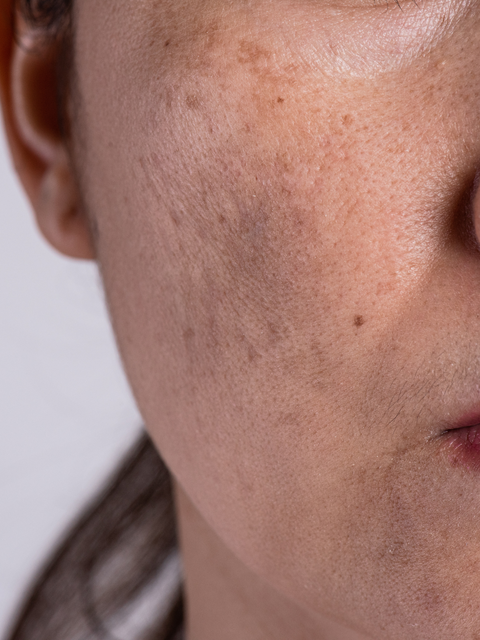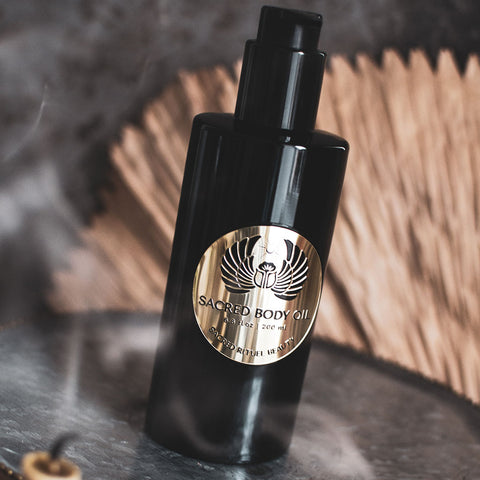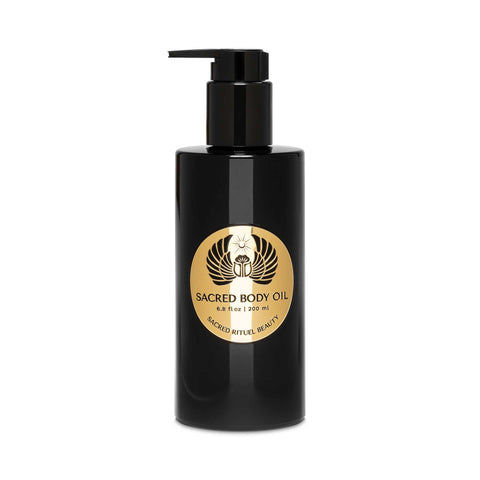
Melasma vs Sun Spots: How To Tell The Difference And Treat Each
Key Takeaways:
- Understanding the Difference: Learn how melasma and sun spots differ in causes, appearance, and treatment.
- Effective Treatments: Explore proven methods to treat both melasma and sun spots for clearer skin.
- Prevention Strategies: Discover essential steps to prevent the recurrence of melasma and sun spots.
At Sacred Rituel, we take pride in our expertise in utilizing the power of Earth's most sacred, healing plants to create skincare solutions that go beyond beauty. Our commitment to purity, potency, and holistic care sets us apart as a leader in natural skincare.
In this piece, we will talk about skin pigmentation issues, focusing on the differences between melasma and sun spots. Understanding these conditions is essential for choosing the right treatment and achieving radiant, even-toned skin.
In this article, we will discuss how to differentiate between melasma and sun spots and explore the most effective treatments for each.
Symptoms Of Melasma
Melasma is primarily recognized by its distinct appearance on the skin, but it’s important to understand the specific symptoms that characterize this condition. Below are the common symptoms of melasma, each with a brief description:
- Brown or Grayish-Brown Patches: The most noticeable symptom of melasma is the presence of flat, discolored patches on the skin. These patches are typically brown or grayish-brown in color and can vary in size and shape. The pigmentation may deepen or spread over time, particularly with continued sun exposure.
- Symmetrical Appearance: Melasma usually appears symmetrically on both sides of the face. For example, if a patch develops on one cheek, a matching patch often appears on the other cheek. This bilateral symmetry is a hallmark of melasma, distinguishing it from other skin conditions.
- Affected Areas on the Face: The most common areas affected by melasma are the cheeks, forehead, nose, and upper lip. These areas are more exposed to sunlight, which can trigger or worsen the condition. In some cases, melasma may also appear on the jawline or neck.
- Darkening with Sun Exposure: One of the key features of melasma is that the pigmentation tends to darken with sun exposure. Even brief exposure to UV rays can intensify the color of the patches, making sun protection crucial for managing the condition.
- Absence of Pain or Itching: Unlike some other skin conditions, melasma does not cause any physical discomfort, such as pain or itching. It is primarily a cosmetic concern, but its impact on appearance can lead to significant emotional distress.
Elevate your self-care routine with our curated collection of best-sellers. From luxurious skincare to rejuvenating body treatments, find the products that our customers can't stop raving about. Don't miss out—experience the sacred ritual that everyone is talking about.
Symptoms Of Sun Spots
Sun spots are a common sign of sun damage and aging, particularly in areas of the skin that have been exposed to sunlight over long periods. Below are the key symptoms of sun spots, with descriptions to help you identify them:
- Flat, Brown, or Black Spots: Sun spots typically present as flat, well-defined areas of increased pigmentation. They are usually brown or black in color and can vary in size from small freckles to larger patches. The color intensity may deepen over time, especially with continued sun exposure.
- Commonly Affected Areas: Sun spots most often appear on parts of the body that are regularly exposed to the sun. The face, hands, shoulders, and arms are the most common sites. These areas are prone to sun spots due to their frequent exposure to ultraviolet (UV) light.
- Gradual Development Over Time: Sun spots tend to develop gradually and are more prevalent in individuals over the age of 40. However, they can also appear in younger people who have had significant or frequent sun exposure. The slow progression of these spots means they often go unnoticed until they become more pronounced.
- No Physical Discomfort: Sun spots are typically asymptomatic, meaning they do not cause any pain, itching, or discomfort. They are primarily a cosmetic concern, but their appearance can be a source of frustration for those affected.
- Persistent and Non-Fading: Unlike some forms of hyperpigmentation, sun spots do not fade on their own over time. Once they develop, they tend to remain unless treated. This persistence makes them a long-term sign of sun damage that may require cosmetic procedures for removal or lightening.

Key Differences Between Melasma And Sun Spots
While both melasma and sun spots result in darkened areas of the skin, they are distinct conditions with different underlying causes, appearances, and responses to treatment. Understanding these differences is crucial for selecting the appropriate treatment and setting realistic expectations for skin improvement.
Causes
The causes of melasma and sun spots differ significantly. Melasma is primarily triggered by hormonal changes, with sun exposure acting as a secondary factor that can worsen the condition. It is commonly linked to pregnancy, the use of birth control pills, and hormone replacement therapy. These hormonal fluctuations stimulate an overproduction of melanin, leading to the characteristic patches of melasma. On the other hand, sun spots, also known as solar lentigines, are directly caused by cumulative exposure to ultraviolet (UV) light over time. They are a clear sign of skin aging and sun damage, rather than being influenced by hormonal changes.
Appearance
Melasma and sun spots also differ in their appearance on the skin. Melasma typically manifests as larger, irregularly shaped patches that often appear symmetrically on both sides of the face. The color of these patches ranges from light brown to gray-brown, giving the skin a blotchy appearance. This symmetry and irregular shape are distinguishing features of melasma. In contrast, sun spots are smaller, well-defined spots that are usually brown or black. They tend to appear more scattered across sun-exposed areas of the skin, such as the face, hands, shoulders, and arms, and lack the symmetry seen in melasma. The clear, defined edges of sun spots make them easier to distinguish from the more diffuse patches of melasma.
Treatment Response
When it comes to treatment, melasma and sun spots respond differently, largely due to their distinct causes and characteristics. Melasma can be more challenging to treat because it is often deeply rooted in the skin and influenced by ongoing hormonal factors. Treatment typically involves a combination of topical treatments, strict sun protection, and in some cases, procedures like chemical peels or laser therapy. Even with these treatments, melasma can be persistent and may recur, requiring ongoing maintenance. In contrast, sun spots are generally easier to treat. They often respond well to topical bleaching agents, laser therapy, or cryotherapy. Since sun spots are more superficial and directly linked to UV exposure, treatment tends to be more straightforward, with a higher likelihood of achieving visible improvement.
How To Diagnose Melasma And Sun Spots
Accurately diagnosing melasma and sun spots is essential for determining the most effective treatment approach. Although both conditions present as darkened areas on the skin, they have distinct characteristics that require professional evaluation. Dermatologists typically use a combination of visual examination, specialized tools, and sometimes additional tests to differentiate between these skin concerns.
Visual Examination
The first step in diagnosing melasma and sun spots usually involves a thorough visual examination by a dermatologist. For melasma, the dermatologist will assess the skin for the characteristic signs, such as symmetrical, larger patches with irregular shapes. These patches are typically found on the face, especially on the cheeks, forehead, nose, and upper lip. The pattern and distribution of the pigmentation are key indicators that help differentiate melasma from other skin conditions. In contrast, sun spots are identified by their appearance as small, well-defined, and scattered dark spots. These spots are most commonly found on sun-exposed areas like the face, hands, shoulders, and arms. The dermatologist's trained eye can often distinguish between melasma and sun spots based on these visual cues alone.
Wood’s Lamp Examination
In cases where a more detailed analysis is needed, a dermatologist may use a Wood’s lamp for examination. This special UV light helps to assess the depth of pigmentation within the skin. The Wood’s lamp can distinguish between superficial pigmentation, which is typically associated with sun spots and is easier to treat, and deeper pigmentation, which is more characteristic of melasma. This deeper pigmentation can be more challenging to manage, and the Wood’s lamp helps to identify the extent of the condition. By using this tool, dermatologists can better tailor treatment plans to the specific needs of the patient, ensuring that the most appropriate therapies are chosen.
Skin Biopsy
In rare instances where the diagnosis remains unclear or when there is a suspicion of another underlying condition, a skin biopsy may be performed. This involves taking a small sample of the affected skin for microscopic analysis. A biopsy can provide definitive information about the nature of the pigmentation and rule out other potential causes, such as skin cancer or other forms of hyperpigmentation. While a biopsy is not commonly required for diagnosing melasma or sun spots, it can be a valuable tool in complex cases where visual examination and other methods do not provide a clear answer.
Importance Of Accurate Diagnosis
Accurate diagnosis is critical for developing an effective treatment plan. Misdiagnosis can lead to ineffective treatments, unnecessary procedures, and potential worsening of the condition. By correctly identifying whether a patient has melasma, sun spots, or another skin condition, dermatologists can recommend the most suitable interventions. This ensures that patients receive the best possible care and achieve the most favorable outcomes.
Effective Treatments For Melasma
Melasma is a challenging condition to treat due to its involvement with deeper skin layers. However, a combination of treatments can help reduce its appearance and prevent it from worsening. Here are the most effective strategies:
- Sun Protection: Sun protection is crucial for managing melasma, as UV exposure is a major trigger. Daily use of a broad-spectrum sunscreen with SPF 30 or higher is essential, with reapplication throughout the day. Wearing hats and protective clothing adds extra protection, significantly reducing flare-ups.
- Topical Treatments: Topical treatments are often the first step in treating melasma. Hydroquinone is a widely used skin-lightening agent that inhibits melanin production. Retinoids, like tretinoin, promote cell turnover, helping to fade hyperpigmentation. Mild corticosteroids may be prescribed to enhance these treatments. Alternatives such as azelaic acid and kojic acid also reduce melanin production and are effective for some patients.
- Chemical Peels: Chemical peels using agents like glycolic acid or salicylic acid help exfoliate the skin and remove pigmented cells. These peels should be done by a professional to avoid complications and can be very effective when combined with other treatments.
- Laser and Light Treatments: Laser and light-based therapies, such as fractional lasers and Intense Pulsed Light (IPL), target melanin to reduce pigmentation. However, these treatments must be administered carefully by experienced professionals, as they can sometimes worsen melasma.
- Oral Medications: In more stubborn cases, oral medications like tranexamic acid may be prescribed. This medication works by affecting blood vessels involved in melasma, helping to reduce pigmentation. It’s typically used when other treatments aren’t sufficient.
- Lifestyle Modifications: Avoiding triggers like hormonal contraceptives and minimizing sun exposure are important for managing melasma. Consistent sun protection and lifestyle adjustments, combined with medical treatments, can help prevent melasma from worsening and maintain improvements.
Best Treatments For Sun Spots
Sun spots, also known as solar lentigines, result from prolonged sun exposure and are generally easier to treat than other forms of hyperpigmentation. With the right approach, these spots can be significantly reduced or eliminated. Here are the most effective treatment options:
- Topical Treatments: Topical treatments are often the first step in addressing sun spots. Bleaching creams with hydroquinone lighten pigmentation over time by inhibiting melanin production. Retinoids help by increasing cell turnover, gradually shedding pigmented skin cells. Vitamin C serums, known for their antioxidant properties, can lighten spots and protect against further UV damage.
- Chemical Peels: Chemical peels use agents like glycolic acid or trichloroacetic acid (TCA) to exfoliate the skin and reduce sun spots. These peels remove the outer layer of pigmented skin cells, promoting the growth of new, healthier skin. For safety and best results, these should be done by a dermatologist.
- Laser Treatments: Laser treatments, including Q-switched and fractional lasers, effectively target and break down melanin in sun spots, leading to their gradual fading. Intense Pulsed Light (IPL) is another option that uses broad-spectrum light to reduce pigmentation and improve skin tone. These treatments offer quicker and more dramatic results than topical options.
- Cryotherapy: Cryotherapy involves applying liquid nitrogen to freeze and remove small sun spots. This quick and effective treatment causes the treated area to peel off, allowing new skin to replace it. It’s particularly useful for isolated spots and should be performed by a professional to avoid complications.
- Microdermabrasion: Microdermabrasion is a non-invasive procedure that exfoliates the outer layer of the skin, helping to reduce sun spots by removing pigmented cells. This treatment can be combined with other methods to enhance results and improve overall skin texture.
- Preventive Measures: Preventing the recurrence of sun spots is crucial. After treatment, consistent sun protection is essential. Use broad-spectrum sunscreen daily, even on cloudy days, and reapply regularly when outdoors. Wearing protective clothing also helps minimize UV exposure, maintaining the results of treatments and preventing new sun spots from forming.

Final Thoughts
Understanding the differences between melasma and sun spots is essential for selecting the right treatment and managing your skin effectively. While both conditions involve pigmentation, their causes, appearance, and treatment responses vary significantly. Melasma, often triggered by hormonal changes, can be more challenging to treat and requires a combination of therapies, strict sun protection, and long-term management. Sun spots, primarily caused by sun exposure, are usually easier to treat with topical agents, lasers, or other dermatological procedures.
Preventing both conditions involves diligent sun protection, a consistent skincare routine, and avoiding known triggers, especially for those prone to melasma. Regular consultations with a dermatologist can help you tailor a treatment plan that suits your skin type and addresses your specific concerns.
By taking proactive steps and choosing the appropriate treatments, you can maintain healthier, more even-toned skin, and reduce the impact of both melasma and sun spots on your appearance.
Read also:
- How to Choose the Right Acne Treatment for You
- Why Organic Skincare is Better for Your Skin
- The Benefits of Using Vegan Skincare Products
Frequently Asked Questions About Melasma And Sun Spots
Can melasma and sun spots appear at the same time?
Yes, it's possible to have both melasma and sun spots simultaneously, especially if you have a history of sun exposure and hormonal fluctuations. Each condition would require a tailored treatment approach.
Are melasma and sun spots hereditary?
While sun spots are more linked to sun exposure, melasma can have a hereditary component, as it often runs in families, especially among those with darker skin tones.
Can diet affect melasma or sun spots?
Certain diets rich in antioxidants can help protect skin from sun damage, potentially reducing sun spots. However, diet alone is unlikely to directly affect melasma, which is more hormonally driven.
Do melasma and sun spots fade on their own?
Sun spots may lighten over time with reduced sun exposure, but they generally do not fade completely without treatment. Melasma, on the other hand, often persists and may even worsen without treatment.
Can over-the-counter products treat both melasma and sun spots?
Some over-the-counter products, like those containing niacinamide or vitamin C, may help lighten both conditions, but prescription treatments are often more effective, especially for melasma.
Are there any natural remedies for melasma and sun spots?
Natural remedies such as aloe vera, green tea extract, and licorice root have shown some promise in lightening hyperpigmentation. However, they may not be as effective as medical treatments and should be used with caution.
Can stress worsen melasma or sun spots?
Stress can indirectly worsen melasma by affecting hormone levels, which can increase pigmentation. Sun spots are not directly affected by stress but are more influenced by UV exposure.
Is there a risk of melasma turning into skin cancer?
Melasma itself is not linked to skin cancer. However, sun spots (solar lentigines) are a sign of sun damage, and excessive sun exposure increases the risk of skin cancer. Regular skin checks are recommended.
Can tanning beds cause melasma or sun spots?
Yes, tanning beds emit UV radiation that can trigger melasma and cause sun spots. It's best to avoid tanning beds to reduce the risk of hyperpigmentation and skin cancer.
Are there any new treatments being developed for melasma and sun spots?
Ongoing research is exploring new treatments, including laser technologies and topical agents, to more effectively target and treat both melasma and sun spots with fewer side effects.
Sources:
- Sehgal, V. N., Verma, P., Srivastava, G., Aggarwal, A. K., & Verma, S. (2011). Melasma: Treatment strategy. Journal of Cosmetic and Laser Therapy, 13(6), 265–279. https://doi.org/10.3109/14764172.2011.630088
- KUCUK, O. S. (2018). Current Treatment Approaches for Melasma. Bezmialem Science, 54–62. https://doi.org/10.14235/bs.2018.1155
- Makino, E. T., Huang, P., Cheng, T., Acevedo, S. F., Cristiane de Oliveira, & Mehta, R. C. (2023). 12-Week, Single-Center Study of a Targeted Pigment-Correcting Dark Spot Treatment for Post-Inflammatory Hyperpigmentation and Solar Lentigines. Clinical, Cosmetic and Investigational Dermatology, Volume 16, 2677–2686. https://doi.org/10.2147/ccid.s427956







Comments (0)
There are no comments for this article. Be the first one to leave a message!